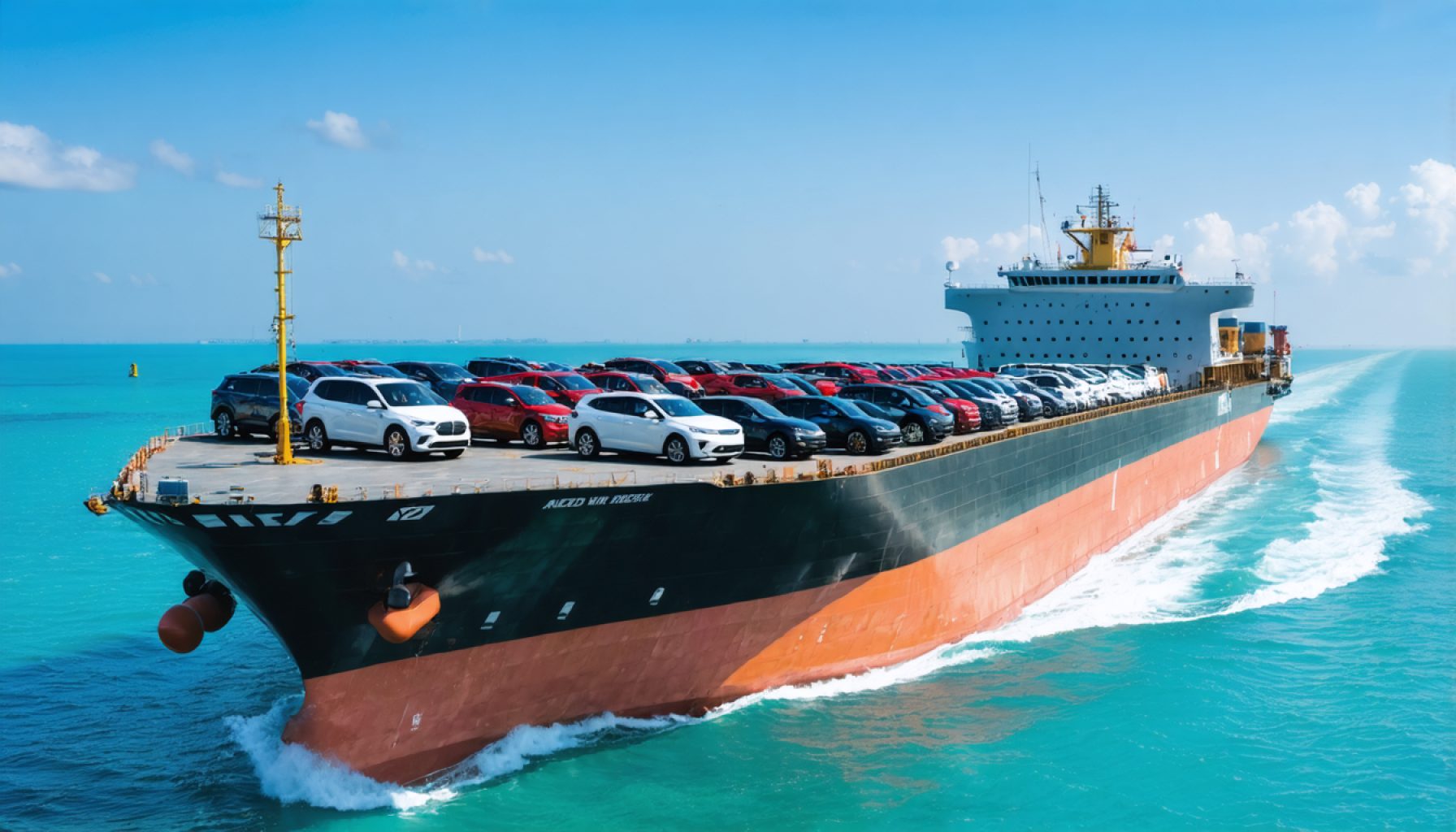- The BYD Shenzhen, the world’s largest roll-on/roll-off ship, embarked on its first voyage from Jiangsu, China, to Brazil, carrying over 7,000 new energy vehicles.
- This engineering marvel, at 219.9 meters long and 37.7 meters wide, can transport up to 9,200 vehicles, symbolizing BYD’s commitment to innovation and sustainable progress.
- The ship highlights BYD’s global leadership in advancing green technologies and expanding the electric vehicle market.
- Brazil, BYD’s largest overseas market, has witnessed significant growth in the brand, particularly with popular models like the Song Pro and Seagull.
- The voyage symbolizes a broader movement towards eco-friendly transportation and aims to foster a shared vision for sustainability worldwide.
- The launch underscores the critical role of innovations in combatting climate change and driving the shift towards a zero-emission future.
The sea was a mirror of glistening possibilities as BYD Shenzhen, the colossal titan of the ocean, embarked on its maiden voyage to Brazil, reshaping the landscape of global automotive distribution. As dawn kissed the horizon over Jiangsu, China, the sound of waves lapping against the hull of this behemoth was matched only by the promise of the cargo it carried—more than 7,000 new energy vehicles destined to revolutionize the Brazilian market.
The Shenzhen, an engineering marvel stretching 219.9 meters long and 37.7 meters wide, is not just a vessel; it is a floating promise of innovation and sustainable progress. With the capacity to carry up to 9,200 vehicles—equivalent to a sprawling area of 20 football fields—this roll-on/roll-off ship is the largest of its kind. Yet, its true significance echoes far beyond sheer size. It is a beacon of the rapid advance in green technologies by the Chinese auto giant, BYD, and a testament to the company’s soaring ambitions.
In this sleek naval fortress, one discovers more than just the intricacy of modern engineering. It represents a pivotal movement towards eco-friendly transportation, as BYD leads the charge in making electric vehicles mainstream across the globe. Brazil, BYD’s largest overseas market, is no stranger to these innovations. The automaker’s meteoric rise over the past two years, punctuated by bestselling models like the Song Pro and the Seagull, has established BYD as the fastest-growing automotive brand in the country.
The real journey of the Shenzhen began long before its launch into the azure depths from Yangzhou. Crafted with precision, each of its 12 decks stands as a tribute to the future of the automotive industry—a future that is increasingly electric. Sailing at a brisk pace of 18.5 knots, the Shenzhen doesn’t just navigate the seas but also propels the global conversation about sustainable transport solutions. Its journey marks a symbolic southward expansion into emerging economies clamoring for greener alternatives.
The launch of BYD Shenzhen is not a mere logistical triumph. It underscores a broader message: as the world grapples with climate change, innovations like BYD’s are crucial for steering our collective future towards sustainability. The ship’s voyage to Brazil hints at a new era where electric vehicles become an inseparable part of the global mobility solution, linking continents not just physically, but through shared responsibility and vision for a cleaner planet.
As we watch this monumental ship fade into the horizon, let it inspire us to embrace a future where technology and nature coexist harmoniously. The journey of the BYD Shenzhen is more than an isolated voyage; it is the beginning of an odyssey towards a zero-emission world, where every turn of the propeller brings us closer to a sustainable tomorrow.
The BYD Shenzhen: A Game-Changer in Global Automotive Distribution
Introduction
The maiden voyage of BYD’s automotive carrier, the Shenzhen, is a landmark event in global eco-friendly transportation. As it set sail to Brazil, the Shenzhen carried more than 7,000 new energy vehicles, symbolizing BYD’s commitment to addressing climate change through innovative transportation solutions. This article delves deeper into various facets of this significant voyage, exploring everything from technical specifications to the broader implications for the automotive industry.
Technical Specifications and Features
The Shenzhen is a behemoth of modern engineering. Spanning 219.9 meters in length and 37.7 meters in width, it is the largest roll-on/roll-off ship in operation today. Capable of carrying up to 9,200 vehicles, the vessel offers unparalleled capacity and efficiency in transportation logistics.
– Speed and Efficiency: The Shenzhen cruises at 18.5 knots, optimizing fuel efficiency while minimizing its environmental impact.
– Design: The ship’s 12 decks are meticulously crafted for optimal space utilization and safety standards, ensuring that vehicles are securely transported across oceans.
Market Insights and Trends
BYD’s emergence as a leader in the electric vehicle (EV) market is underscored by this strategic move into Brazil, its largest overseas market for EVs. The skyrocketing demand for models like the Song Pro and Seagull spearheads a broader adoption of green technologies in this burgeoning economy.
– Industry Forecasts: According to industry reports, the global roll-on/roll-off transport market is projected to grow as the need for efficient, large-scale vehicle transport solutions increases.
Pros & Cons Overview
Pros:
1. Sustainability: As a carrier of new energy vehicles, the Shenzhen significantly reduces the carbon footprint associated with traditional vehicle transport.
2. Capacity: Offering storage equal to 20 football fields, it efficiently supports high-demand routes such as China to Brazil.
3. Technological Leadership: Showcases BYD’s engineering prowess in both automotive and maritime sectors.
Cons:
1. Initial Cost: High upfront costs for such massive vessels can pose financial challenges.
2. Niche Application: The focus on new energy vehicles may limit versatility in serving broader market needs.
Controversies and Limitations
Despite its groundbreaking design, the BYD Shenzhen may face limitations regarding adaptability to varying international shipping regulations. Moreover, the dependency on continued growth in the EV market is a potential risk factor.
Security & Sustainability
BYD’s focus on sustainability extends beyond the vehicles it transports. The Shenzhen is positioned to incorporate future-ready technologies such as automated navigation systems and green hull technologies to further reduce emissions.
Actionable Recommendations
1. Adoption of EVs: Consumers and businesses are encouraged to explore electric vehicle options, reducing their carbon footprint and contributing to a cleaner environment.
2. Investment in Green Fleet Technologies: Businesses should consider investing in green shipping options for transporting vehicles globally.
Conclusion
The Shenzhen’s journey signifies a huge step towards a sustainable future, where more ships of its kind will likely dominate the logistics landscape. As a leader in the EV market, BYD’s ongoing innovation heralds a promising future for global transportation.
Explore More About BYD: For more information on BYD’s initiatives and technology, visit their main website: BYD Global.
The Shenzhen’s voyage marks the dawn of a new era in automotive distribution, inspiring us to embrace sustainable practices in personal and commercial transportation alike.
 North Las Vegas & Enterprise Real Estate: Market Expansion, Trends, and Long-Term Projections
North Las Vegas & Enterprise Real Estate: Market Expansion, Trends, and Long-Term Projections  Blue Origin’s Bold Comeback: “Never Tell Me The Odds” Booster to Challenge SpaceX With August Launch
Blue Origin’s Bold Comeback: “Never Tell Me The Odds” Booster to Challenge SpaceX With August Launch  Billion-Euro Bet: UK Supercharges Global Race for Limitless Fusion Energy with Marvel Fusion Deal
Billion-Euro Bet: UK Supercharges Global Race for Limitless Fusion Energy with Marvel Fusion Deal  Dell’s Bold Move: New India Head, Surging AI Partnerships, and a Stock Price Rocketing 24%—What’s Next for This Tech Giant?
Dell’s Bold Move: New India Head, Surging AI Partnerships, and a Stock Price Rocketing 24%—What’s Next for This Tech Giant?  Lucid Group’s Bold Boardroom Shakeup: Is a Turnaround Finally Coming for This EV Underdog?
Lucid Group’s Bold Boardroom Shakeup: Is a Turnaround Finally Coming for This EV Underdog?  JWST’s Largest Cosmic Map Ever Stuns Astronomers: See Nearly 800,000 Ancient Galaxies in Unprecedented Detail
JWST’s Largest Cosmic Map Ever Stuns Astronomers: See Nearly 800,000 Ancient Galaxies in Unprecedented Detail  Russia’s Air Power Shaken: Shocking Satellite Images Reveal Scale of Ukraine’s Latest Drone Strike
Russia’s Air Power Shaken: Shocking Satellite Images Reveal Scale of Ukraine’s Latest Drone Strike  XRP Skyrockets: Wall Street and Asia Rush to Make Ripple Token the Next Big Treasury Asset
XRP Skyrockets: Wall Street and Asia Rush to Make Ripple Token the Next Big Treasury Asset  Spatial Transcriptomics Analysis Platforms Market 2025: Rapid AI Integration Drives 18% CAGR Through 2030
Spatial Transcriptomics Analysis Platforms Market 2025: Rapid AI Integration Drives 18% CAGR Through 2030 